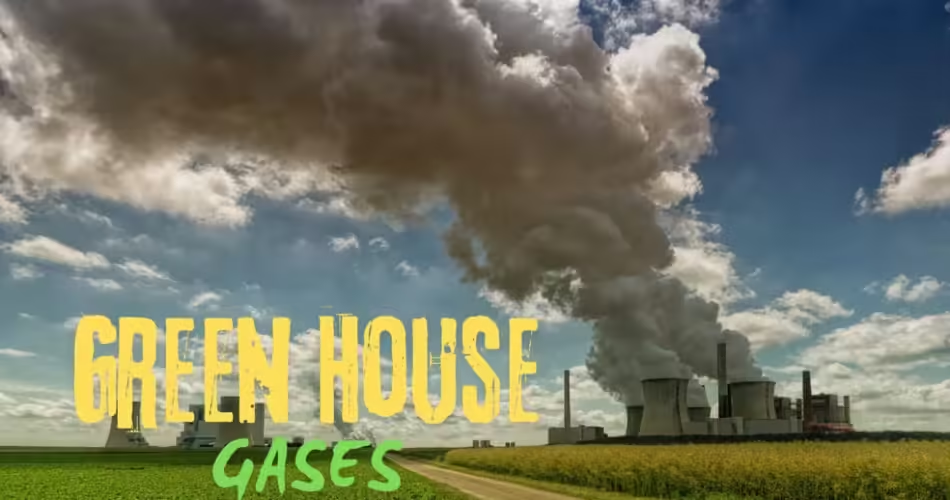This blog will tell you about Green House Gases. It will highlight the cause of Green House Gases productions. It will also mention 5 main Green House Gases and their sources. This will guide you about 10 strategies that can help us to control Green House Gas Emissions. This is a complete explanation of Green House Gases and all the detail required. This blog will explains how effects of Green House Gases leads to Global Warming.
What are Green House Gases?
Green House Gases are the gases that increase the temperature of the Earth to make life possible on Earth. Without greenhouse gases the Earth will be frozen and there will be no life. But unfortunately the concentration of these gases has increased at a great level that is dangerous.
The gases responsible for holding the outgoing IR radiation are called greenhouse gases. Levels of these “greenhouse gases” have increased at a rapid rate during recent decades and are continuing to do so. In particular, methane, chlorofluorocarbons (CFCs), and nitrous oxide absorb infrared 50 to 10 fold more effectively than carbon dioxide.
Some of these are Anthropogenic and some are mostly occurred naturally. But due to anthropogenic activities, the addition in these green house gases, the Earth is becoming warmer and the environment is polluting at great levels.
Green House Gases are the great cause of Global Warming because they are trapped within the atmosphere and eventually increase the temperature of the Earth on global level. This is causing melting of glacier, sea level rise and other environmental hazards every year and the weather activities are becoming extreme.
Causes of Greenhouse Gases Emission:
Following are the main causes of Green House Gas emission:
(i) Burning of Fossil Fuels:
Fossil fuels like coal, oil and natural gas have become an integral part of our life. When they are burnt, the carbon stored inside them is released which combines with oxygen in the air to create carbon dioxide. Apart from that, electricity-related emissions are high because we are still dependent on coal for electricity generation which releases large amount of CO, into the atmosphere and is still the primary source of fuel for generating electricity. Although, renewable sources are catching up, but it may take a while before we can reduce our dependence on coal for electricity generation.
(ii) Deforestation:
Forests hold a major green area on the planet Earth. Plants and trees intake carbon dioxide and release oxygen, through the process of photosynthesis, which is required by humans and animals to survive. Large scale development has resulted in cutting down of trees and forests which has forced people to look for alternative places for living. When the wood is burnt, the stored carbon is converted back into carbon dioxide.
(iii) Farming:
Nitrous oxide is one the greenhouse gas that is used in fertilizer and contributes to greenhouse effect which in turn leads to global warming. Agriculture and farming contributes a lot in the green house gases emission and enhance its effects.
(iv) Industrial Waste and Landfills:
Industries which are involved in cement production, fertilizers, coal mining activities, oil extraction produce harmful greenhouse gases. Also landfills filed with garbage produce carbon dioxide and methane gas contributing significantly to greenhouse effect.
(v) Increase in Population:
Over the last few decades, there have been huge increase in the population. Now, this has resulted in increased demand for manufacturing hubs have come up cities and town that release some harmful gases into the atmosphere which increases Greenhouse effect. Also more people means more usage of fossil fuels which in turn has aggravated the problem.
All of these are Anthropogenic Causes of Green House Gases emissions that results in the enhancement of Green House Effect and Global Warming.

Main Green House Gases:
Following are some of the Green House Gases:
1.Carbon dioxide (CO2)
The CO2 is considered as the major factor of greenhouse effect. The troposphere (2010) and 50.375% CO2 Its concentration is increased from 350 ppm (190) to 700 ppm CO2 and is expected to be greater than 700 ppm in near future. The net annual increase of CO2 in the air is 0.77 ppm. Fossil fuels and clearness of forests are major causes of increased concentrations of CO2.
Sources:
Industries
Transportation
Agriculture etc.
2. Chlorofluorocarbons (CFC’s)
The main sources of chlorofluorocarbons include air conditioners, refrigerators, evaporation of industrial solvents, production of plastic foams, aerosols. etc. The concentration of CO2 is rising 5% per year. CFC’s trap heat 20,000 times more efficiently than CO2 and also destroys ozone layer. CFC’s are responsible for 14-24% of global warming.
Sources:
Refrigerators
Air Conditioners etc.
3.Methane (CH4)
Methane is produced by number of ways such as action of anaerobic bacteria on vegetation, decomposition of organic matter, incomplete combustion of vegetation, natural gas pipeline leaks and petroleum oil etc. It is rising 2% approximately every year. It absorbs 20 – 25% times more heat than CO2. In addition to acting as a greenhouse gas, methane has significant effects upon atmospheric chemistry. It produces atmospheric CO as an intermediate oxidation product and influences concentrations of atmospheric hydroxyl radicals and ozone. In the stratosphere, it produces hydrogen and H2O, but acts to remove ozone destroying chlorine.
Sources:
Livestock
Agriculture
Landfills etc.
4. Nitrous oxide (NO)
Nylon products release Nitrous oxide, from burning of biomass and fuels. This gas is responsible for about 6% of global warming. It absorbs about 250 times more heat than CO2. Besides trapping heat in the troposphere it also depletes ozone in the stratosphere. The NO concentration in the atmosphere is 0.3 pm and is increasing 0.2% annually.
Sources:
Combustion of nitrogen fuels
Cars and truck exhausts
Power generation plants etc.
5.Ozone
It comes mostly from hydrocarbons and nitrogen oxides. It causes irritation to eyes and respiratory organs. Besides these water vapors also act as greenhouse gas. The potential of such a gas to cause greenhouse warming may be expressed by a global warming potential GWP, which is a function of both the infrared absorption characteristics and the lifetime of the gas. The greenhouse gases can be arranged in GWP sequence as follows:
CFC> N2O>CH4>CO2
Sources:
Industrial Boilers
Refineries and Chemical plants
Automobile pollution etc.
These are the natural and enhanced major green house gases along with their anthropogenic sources thus increase Global Warming.
10 Strategies to Control GHG emissions:
You can help to reduce the demand for fossil fuels, which in turn reduces global warming, by using energy more wisely. The following is a list of 10 steps one can take to reduce greenhouse gas emissions:
1. Reduce, Reuse, Recycle
Buying products with minimal packaging will help to reduce waste. By recycling half of your household waste, you can save 2,400 pounds of carbon dioxide annually.
2. Use Less Heat and Air Conditioning
Adding insulation to your walls and installing weather stripping or calking around doors and windows can lower your heating costs more than 25 percent, by reducing the amount of energy you need to heat and cool your home. Turn down the heat while you’re sleeping at night or away during the day, and keep temperatures moderate at al times. Install a programmable thermostat because setting to just 2 degrees lower in winter and higher in summer could save about 2,000 pounds of carbon dioxide each year.
3.Replace Your Light Bulbs
Wherever practical, replace regular light bulbs with Compact florescent light (CFL) bulbs. Replacing just one 60-watt incandescent light bulb with a CFL will save you $30 over the life of the bulb. CFLs also last 10 times longer than incandescent bulbs, use two-thirds less energy, and give off 70 percent less heat. If every Canadian family replaced one regular light bulb with a CFL, it would eliminate 90 billion pounds of greenhouse gases, the same as taking 7.5 million cars off the road.
4.Drive less and Drive Smart
Less driving means fewer emissions. Besides saving gasoline, walking and biking are great forms of exercise. Explore the York Region Transit system and check out options for carpooling to work or school. When you do drive, make sure your car is running efficiently. For example, keeping your tires properly inflated can improve your gas mileage by more than 3 percent. Every gallon of gas you save not only helps your budget, it also keeps 20 pounds of carbon dioxide out of the atmosphere.
5.Buy Energy-Efficient Products
Home appliances now come in a range of energy-efficient models. Compact florescent bulbs are designed to provide more natural-looking light while using far less energy than standard light bulbs. These products will save the energy and help you to conserve the energy without sacrificing your needs.
6.Use Less Hot Water
Set your water heater at appropriate temperature to save energy, and wrap it in an insulating blanket if it is more than 15 years old. Buy low-flow shower heads to save hot water and about 350 pounds of carbon dioxide yearly. Wash your clothes in warm or cold water to reduce your use of hot water and the energy required to produce it. That change alone can save at least 500 pounds of carbon dioxide annually in most households.
7.Use the “Off” Switch
Save electricity and reduce global warming by turning of lights when you leave a room, and using only as much light as you need. And remember to turn off your television, stereo and computer when you’re not using them. It’s also a good idea to turn off the water when you’re not using it. While brushing your teeth, shampooing the dog or washing your car, turn off the water until you actually need it for rinsing.
8.Plant a Tree
If you have the means to plant a tree, start digging. Trees absorb carbon dioxide and give off oxygen. A single tree will absorb approximately one ton of carbon dioxide during its lifetime.
9. Get a Report Card from Your Utility Company
Many utility companies provide free home energy audits to help consumers identify areas in their homes that may not be energy efficient. In addition, many utility companies offer rebate programs to help pay for the cost of energy-efficient upgrades.
10. Encourage Others to Conserve
Share information about recycling and energy conservation with your friends, neighbors and co-workers, and take opportunities to encourage public officials to establish programs and policies that are good for the environment.
These 10 steps will take you a long way toward reducing your energy and eventually reduce the GHG emissions. These steps with help you stop Green House Gases as well as Global Warming. These steps will help us to secure our planets and in other words Save the Earth.

To learn about more topics, click the links below:


Comments